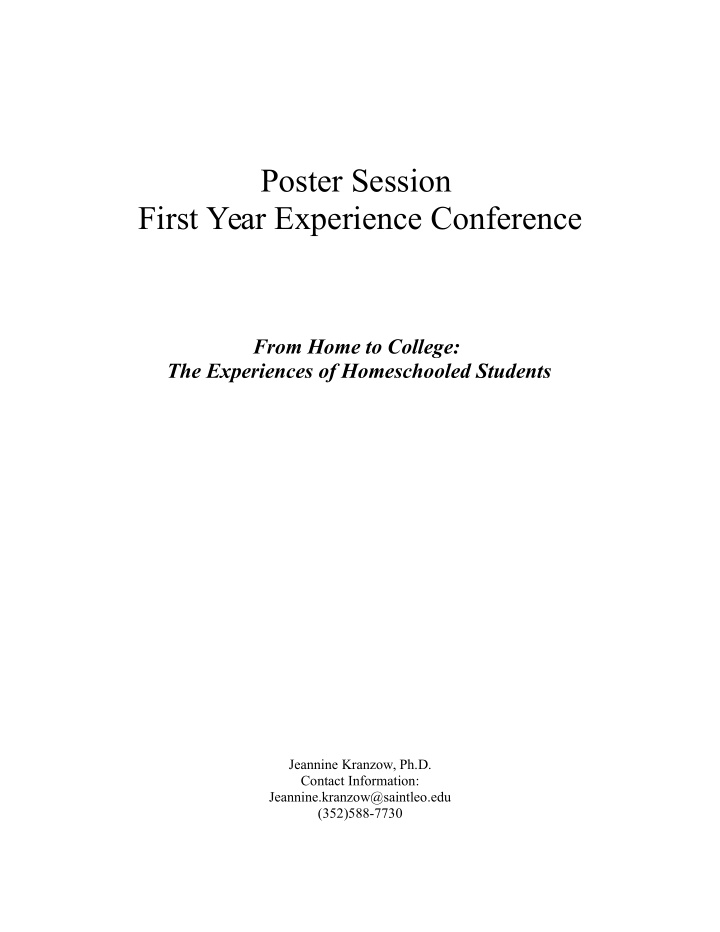



Poster Session First Year Experience Conference From Home to College: The Experiences of Homeschooled Students Jeannine Kranzow, Ph.D. Contact Information: Jeannine.kranzow@saintleo.edu (352)588-7730
From Home to College: The Experiences of Homeschooled Students Current Homeschool Figures: It is estimated that at least 1.1 million students are being homeschooled (Hill, 2000; Princiotta, Bielick, & Chapman, 2004). To put this number into perspective, consider that this is approximately the number of children in the Los Angeles and Chicago public school systems combined (Hill, 2000) and that only 11 states in this country enroll more than a million students (Ballmann, 1995). In the state of Wisconsin, the homeschool population grew by more than 1500% between 1994 and 1999 (Luebke, 1999). Problem: – Researchers have gathered information in regard to how homeschoolers perform academically during the K-12 years (Klicka, 2000; Rudner, 1999). – These studies have strong evidence to suggest that homeschooling is effective in teaching academics. – Research has documented that student satisfaction in college is related to both academic and social experiences (Pascarella & Terenzini, 1995), and that in-class and out-of-class activities impact one another (Banta & Kuh, 1998). – With the increasing numbers of homeschooled students who will be reaching college/university age within a few years, there is a need for research on the long-term effects of homeschooling, as it relates to socialization, social experiences, adjustment to and satisfaction with college. 2
Research Questions • Does Weidman’s (1989) socialization model adequately explain the transition to college process for the homeschooled population? • To what degree do student/parent relationships and peer relationships impact a homeschooled student’s adjustment to college? • Do homeschooled students believe they are socially prepared for college? • Do administrators who interact with homeschoolers perceive a difference in the social behaviors of homeschooled and non homeschooled populations? • To what degree do homeschoolers feel their expectations of college are consistent with their realities? Qualitative Study Sample Included: • Convenient and Purposeful Sample • Two small, private, Christian institutions • 18 first and second year full-time college students who were homeschooled at least through high school (the majority turned out to have been entirely homeschooled) • Six administrators 3
Findings • Weidman’s model of socialization appears to be comprehensive enough to extend to the homeschooled population. • Family and outside peers seem to have continual, prominent influence on students…even once they are living away from home. • Institutional and institutional peer influences appear tempered by past and existing relationships with parents and students. • Looking to Tinto’s model, all three stages – separation, transition, and incorportation look different for homeschooled students. • Variables which typically influence college student adjustment but which seemed to play a particularly important role in the lives of homeschooled students include institutional size and faculty/student interaction. – Interestingly, students from homeschooled backgrounds appear to feel little or no peer pressure to conform to traditionally educated student values (this data is contrary to Astin’s 1993 findings which use a larger population and a more traditional sample). – Another apparent finding worth looking into further is that faculty/student relationships appear to play an even more important role in the lives of homeschooled students than they do in the lives of the traditionally educated. How can institutions assist? • Communication (admissions and student affairs should discuss their experiences with the population) • Communication with students – Clear expectations and description of services available • Communication with parents and students about what might assist students as they prepare for college • Evaluate residence halls (look at blending class levels) • Strong peer mentoring (especially in the very early weeks of school) 4
REFERENCES Astin, A. W. (1993). What matters in college: Four critical years revisited (1st ed.). San Francisco: Jossey-Bass. Ballmann, R. E. (1995). The how and why of home schooling (2nd ed.). Wheaton, IL: Goodnews Publishers. Banta, T. W., & Kuh, G. D. (1998). A missing link in assessment. Change, 30 (2), 1-11 (reprinted in EBSCO, XML full text). Hill, P. T. (2000). Home schooling and the future of public education. Peabody Journal of Education, 75 (1/2), 1-10 (reprinted in XML full text). Klicka, C. J. (2000, March 9). Home schooled students excel in college . Retrieved November 7, 2001, from http://www.hslda.org/docs/nche/000000/00000017.asp Luebke, R. V. (1999). Homeschooling in Wisconsin: A review of current issues and trends. 24 (4), 1-35. Pascarella, E. T., & Terenzini, P. T. (1995). The impact of college on students: Myths, rational myths, and some other things that may not be true. In NACADA Journal (Vol. 15): Edward-Lynne Jones & Associates, Inc. (Reprinted in ASHE reader series, Foundations of American higher education, pp. 153-161). Princiotta, D., Bielick, S., & Chapman, C. (2004). (Issue Brief No. NCES 2004-115): National Center for Educational Statistics. Rudner, L. M. (1999). Scholastic Achievement and Demographic Characteristics of Home School Students in 1998 . Retrieved September 21, 2004 from hthttp://epaa.asu.edu/epaa/v7n8/ Tinto, V. (1993). Leaving college: Rethinking the causes and cures of student attrition (2nd ed.). Chicago: University of Chicago Press. Weidman, J. (1989). Undergraduate socialization: A conceptual approach. In J. Smart (Ed.) Higher education: Handbook of theory and research (Vol. 5). New York: Agathon. 5
Recommend
More recommend